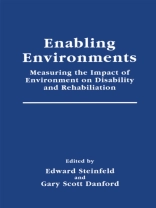TItis volume is the first effort to compile representative work in the emerging research area on the relationship of disability and physical environment since Barrier-Free Environments, edited by Michael Bednar, was published in 1977. Since that time, disability rights legislation like the Americans, with Disabilities Act in the United States, the worldwide growth of the independent-living move- ment, rapid deinstitutionalization, and the maturation of functional assessment methodology have all had their impact on this research area. The impact has been most noticeable in two ways-fostering the integration of environmental vari- ables in rehabilitation research and practice, and changing paradigms for environ- mental interventions. As the contributions in this volume demonstrate, the relationship of disabil- ity and physical environment is no longer of interest primarily to designers and other professionals concerned with managing the resources of the built environ- ment. The physical environment has always been recognized as an important variable affecting rehabilitation outcome. Until recently, however, concepts and tools were not available to measure its impact in clinical practic~ and outcomes research. In particular, lack of a theoretical foundation that integrated environ- ment with the disablement process hampered development of both research and clinical methodology. Thus, the physical environment received little attention from the mainstream rehabilitation research community. However, this situation is changing rapidly.
G. Scott Danford & Edward Steinfeld
Enabling Environments [PDF ebook]
Measuring the Impact of Environment on Disability and Rehabilitation
Enabling Environments [PDF ebook]
Measuring the Impact of Environment on Disability and Rehabilitation
Dieses Ebook kaufen – und ein weitere GRATIS erhalten!
Sprache Englisch ● Format PDF ● ISBN 9781461548416 ● Herausgeber G. Scott Danford & Edward Steinfeld ● Verlag Springer US ● Erscheinungsjahr 2013 ● herunterladbar 3 mal ● Währung EUR ● ID 4661484 ● Kopierschutz Adobe DRM
erfordert DRM-fähige Lesetechnologie












